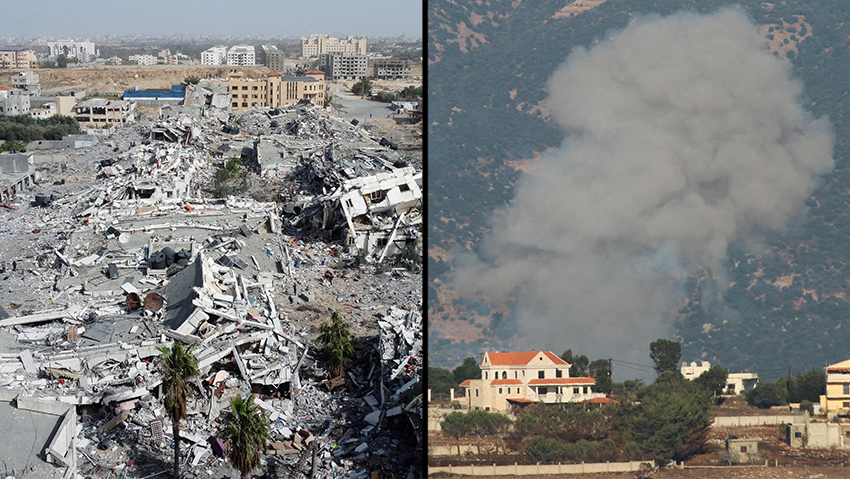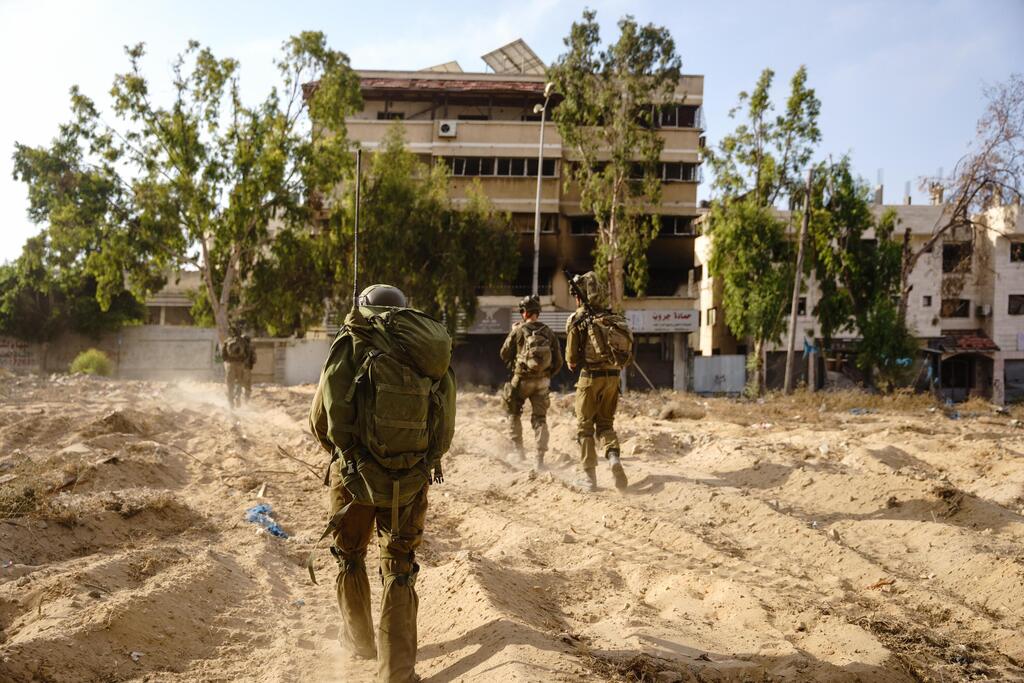Getting your Trinity Audio player ready...
The current situation heading into the weekend offers little in the way of good news. The U.S. proposal on a hostage deal and a cease-fire remains stalled, likely due to new demands from Hamas.
While Prime Minister Benjamin Netanyahu hasn't completely given up on the issue of the Philadelphi Corridor, his envoy, Strategic Affairs Minister Ron Dermer, has presented the Americans with several options for flexibility. However, this doesn’t seem to be the primary sticking point in the negotiations.
2 View gallery


IDF strikes in Gaza and southern Lebanon
(Photo: REUTERS/Karamallah Daher, REUTERS/Bassam Masoud)
The main issue appears to be Hamas leader Yahya Sinwar’s insistence on securing the release of a number of Palestinian security prisoners in Israeli jails, regardless of how many hostages Hamas releases as part of the humanitarian phase.
As a result, the American compromise proposal remains at an impasse. Nonetheless, it’s likely that the U.S., in coordination with Qatar and Egypt, will release a compromise offer by Sunday.
The goal is to force both sides to respond to the proposal, potentially identifying who is at fault for derailing the process. This could lead to increased pressure from both Gazans and Israelis working to free the hostages, which may pave the way for another "bridging proposal."
Preparing for prolonged war as hopes for US mediation fade
Israel’s political and defense establishment has reached a consensus that the chances of securing a breakthrough deal leading to a six-week cease-fire are slim to nonexistent. In response, Prime Minister Benjamin Netanyahu convened a security meeting on Thursday evening with negotiation teams and top defense officials to prepare for the likelihood of an extended war on all fronts, without a hostage deal in sight.
Footage of IDF operations in the West Bank, Gaza Strip and the northern sector
(Video: IDF Spokesperson's Unit)
It might take about a week to ten days to know for certain whether a deal will be reached, as that is typically the time needed for Sinwar and the group’s leadership in Doha to respond to mediated proposals. There remains a faint possibility of a deal and cease-fire, which could lead to further negotiations over a long-term security arrangement in Gaza, including the potential for civilian governance to replace Hamas.
However, Israeli officials are not pinning much hope on the U.S. mediation efforts, viewing any forthcoming proposals as a means to maintain negotiation momentum and prevent Iran and its allies from escalating the situation into a broader regional conflict. In light of the stalled talks, Israel is preparing for an intense and prolonged military campaign, including potential escalations in the north and the West Bank.
Israel prepares for Phase D: Primarily above-ground combat
As Israel shifts its military operations in Gaza to the next stage, details of the strategy remain undisclosed. However, it is expected that the fighting will move into Phase D, where operations will focus primarily on above-ground tactics based on intelligence, with an emphasis on preventing the return of residents and gunmen to northern Gaza through a military presence and offensive actions along the Netzarim Corridor. The goal is to avoid positioning Israeli forces in static posts that could become targets for Hamas guerrilla warfare, particularly in the Netzarim and Rafah areas.
While Israeli officials believe Hamas is militarily weakened, they acknowledge that the group remains capable of conducting guerrilla warfare. Hamas is no longer seen as a terror army capable of launching rockets deep into Israeli territory, but rather as a force reverting to tactics used during the early stages of the Second Intifada. In response, the IDF plans to implement mobile, above-ground operations, focusing on areas where hostages are not believed to be located.
IDF strikes terror sites in southern Lebanon
(Video: IDF Spokesperson's Unit)
Security officials also assess that Hamas and Palestinian Islamic Jihad (PIJ) have received orders to harm Israeli hostages if IDF forces get too close. To counter this, Israel will impose a siege on Hamas, restricting their movement above ground while using intelligence and surveillance to maintain pressure on the militants.
The prolonged time spent underground is expected to increase pressure on the fighters, pushing Sinwar toward a potential deal without endangering the hostages. This approach will replace the intense military campaign conducted across Gaza, aiming to intensify pressure on Hamas leadership while safeguarding hostages.
How to prevent aid from reaching Hamas?
On Thursday, discussions likely addressed "the day after," particularly regarding the distribution of humanitarian aid in Gaza. Following directives from Prime Minister Netanyahu, Israeli defense officials began exploring the possibility of the IDF taking direct control of aid distribution in the Gaza Strip, given that international aid has repeatedly been hijacked by Hamas.
Hamas and PIJ have used food, fuel, and medical supplies to sustain their fighters underground and in hiding above ground. They have also sold stolen aid, particularly food and fuel, in Gaza markets, using the profits to pay their fighters and recruit new members.
Israeli security officials believe this phenomenon hinders the collapse of Hamas, especially its civil control in Gaza. One alternative under consideration is the Generals’ Plan, devised by former IDF General Giora Eiland. The proposal suggests that the IDF would instruct the remaining 300,000 non-combatant civilians in northern Gaza to relocate to safer areas in central Gaza, using coastal routes and designated checkpoints, where terrorists could be identified. Once the evacuation is complete, the IDF would halt the flow of food, fuel and supplies to the north, enabling aggressive military action against the remaining 5,000 terrorists in key northern areas and facilitating the destruction of tunnels.
Both the IDF-controlled aid distribution and the northern Gaza plan are still under consideration. However, they are designed to pressure Hamas via Gaza's civilian population without endangering hostages or violating international law. Israel aims to balance American demands for humanitarian aid to Gaza's non-combatant population while ensuring that the aid does not bolster Hamas or PIJ's control in Gaza.
Slim chance for resolution in the north
A key topic discussed during Thursday’s meeting was the growing need to return displaced northern residents to their homes and ensure both a sense of security and physical safety that was lacking before October 7, 2023.
The original plan was to use a potential cease-fire following a hostage deal—one that Hezbollah's leader Hassan Nasrallah had signaled he would honor by halting fire—as a basis to negotiate an arrangement in the north. This would partially implement UN Security Council Resolution 1701, pushing Hezbollah fighters and their heavy weaponry at least 10 kilometers from Israel's border.
IDF strikes terror sites in southern Lebanon
(Video: IDF Spokesperson's Unit)
However, with the likelihood of a hostage deal appearing slim in the near future, the U.S. has begun secret negotiations with Lebanese officials in an attempt to secure an agreement before stability is restored in Gaza.
According to U.S. sources, the chances of reaching such an agreement, even if a Gaza cease-fire occurs, are low. Nasrallah remains adamant, refusing to pull his forces and weapons away from the border. Israeli officials estimate that a broad military offensive in Lebanon—air, naval and ground—will soon be necessary to achieve militarily what Nasrallah is unwilling to concede through U.S. mediation, with quiet backing from both Saudi Arabia and the UAE.
The IDF has already begun preparations for a large-scale aerial and ground campaign in southern Lebanon. This comes after the success of the IDF's preemptive strike against Hezbollah on August 25, thwarting Hezbollah's plans for a retaliatory rocket and drone attack on northern Israel and two key military targets in central Israel. The preemptive airstrike destroyed hundreds of rocket launchers aimed at northern Israel and beyond, severely damaging Hezbollah's capacity to strike Israel's northern region and its interior. Most of the launchers were concealed underground in the dense foliage of southern Lebanon.
Recent satellite images of these launchers before and after the attacks show a red 'X' marking dense, green terrain on a hilltop or valley. Post-strike images reveal disassembled, charred launchers, with scattered debris and exposed terrain where the launcher had been hidden. Numerous such images are stored at Israel’s Air Force headquarters, and assessments suggest that Hezbollah’s ability to launch short-range rockets, up to areas like Acre and the Haifa Bay, has been significantly diminished.
Systematic destruction of launchers and improved drone interception
Hezbollah still retains significant launching capabilities, but the Israeli Air Force, in preparation for a potential large-scale offensive in southern Lebanon, is systematically destroying these launchers based on intelligence or a specialized "launcher-hunting" method developed by Northern Command and the Air Force. Once a launcher fires, it is struck within minutes.
IDF strikes terror sites in southern Lebanon
(Video: IDF Spokesperson's Unit)
This intense effort in recent days aims to minimize the damage to Israel’s home front should the IDF launch ground operations into southern Lebanon and strike other targets from the air. Meanwhile, Israel has made notable progress in drone interception, with a growing percentage of Hezbollah's drones being successfully shot down due to improved detection systems.
Current deliberations focus on the scale of a potential ground and air operation. Two main considerations are guiding these decisions: first, Hezbollah's ability to strike the Israeli home front during a major or full-scale conflict; second, the possibility that Iran could intervene in support of Hezbollah, potentially sparking a regional war that the U.S. is keen to avoid.
As such, Israel is working to align with American demands, as a defense official noted, "We will need the U.S. with us in the north—whether through diplomatic negotiations to secure an agreement or, more likely soon, in a military campaign in Lebanon that will allow displaced northern residents to return to rebuild their homes and feel secure."
It appears that a decision from Israel's political and military leadership to launch such an operation is closer than ever, with Northern Command preparing intensively. The U.S. has already positioned two naval and air task forces in the region, with aircraft carriers and destroyers stationed near Iran and the Red Sea, ready to neutralize threats from these areas.
Should an intense and prolonged war erupt on multiple fronts, the IDF’s primary challenge will be stretching its manpower, including reservists, to the limit—an issue whose sustainability remains uncertain.






